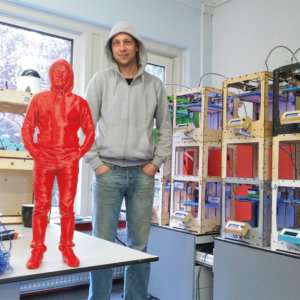Innovation Lessons From 3-D Printing
When people in online user communities start collaboratively developing open-source innovations that have the potential to change an industry, how should the existing companies in the industry respond?
Topics
These days, 3-D printing is big news.1 The use of 3-D printing and other related technologies is seen as having potentially transformative implications. “Just as the Web democratized innovation in bits, a new class of ‘rapid prototyping’ technologies, from 3-D printers to laser cutters, is democratizing innovation in atoms,” Wired magazine’s longtime editor-in-chief, Chris Anderson, stated in his new book Makers: The New Industrial Revolution.2 “A new digital revolution is coming, this time in fabrication,” MIT professor Neil Gershenfeld wrote in a recent issue of Foreign Affairs.3
But in addition to 3-D printing’s technological implications, recent evolutions in 3-D printing offer important management lessons for executives about the changing face of technological innovation — and what that means for businesses. In this article, we examine the rapid emergence of a movement called open-source 3-D printing and how it fits into a general trend toward open-source innovation by collaborative online communities. We then discuss how existing companies can respond to open-source innovation if it occurs in their industry — and whether such collaborative innovation projects represent a threat or an opportunity for existing businesses.
Trends in 3-D Printing
Also known as “additive manufacturing” or “rapid prototyping,” 3-D printing is the printing of solid, physical 3-D objects. Unlike machining processes, which are subtractive in nature, 3-D printing systems join together raw materials to form an object. Drawing on a computer-aided design (CAD) file, the design for an object is first divided into paper-thin, cross-sectional slices, which are then each ‘printed’ out of liquid, powder, plastic or metal materials in sequence until the entire object is created. The use of 3-D printing makes it possible to build physical models, prototypes, patterns, tooling components or production parts. Design and manufacturing organizations use it for product parts in the consumer, industrial, medical and military markets.
The longer-term implications of 3-D printing technologies are believed to be large.4 Direct advantages include enabling designers to operate more efficiently and conveniently. They can quickly prototype their designs in order to test their viability or demonstrate them.
References
1. In newspapers and magazines, 3-D printing has been described enthusiastically as everything from “the technology that could re-shape the world” to “one that is about to transform every single aspect of our lives.” See, for example, S. Richmond, “3D Printing: The Technology That Could Re-Shape the World,” The Telegraph, July 28, 2011; and H. Lipson, “3D Printing: The Technology That Changes Everything,” New Scientist, July 30, 2011, p. 20.
2. C. Anderson, “Makers: The New Industrial Revolution” (New York: Crown Business, 2012): 14.
3. N. Gershenfeld, “How to Make Almost Anything: The Digital Fabrication Revolution,” Foreign Affairs 91, no. 6 (November-December 2012): 43-57.
4. T.T. Wohlers, “Wohlers Report 2012: Additive Manufacturing and 3D Printing State of the Industry, Annual Worldwide Progress Report” (Fort Collins, Colorado: Wohlers Associates, 2012). This annual report elaborates substantially on the 3-D printing industry, technologies and trends.
5. Ibid., p. 125 and 131.
6. Ibid., p. 133. See also “Stratasys and Objet Complete Merger,” Stratasys press release, December 3, 2012, http://investors.stratasys.com/releasedetail.cfm?ReleaseID=724378.
7. Ibid., p. 65 and 256.
8. E. de Bruijn, “On the Viability of the Open Source Development Model for the Design of Physical Objects: Lessons Learned From the RepRap Project” (master’s thesis, Tilburg University, 2010).
9. Wohlers, “Wohlers Report 2012,” p. 137.
10. C. Baldwin and E. von Hippel, “Modeling a Paradigm Shift: From Producer Innovation to User and Open Collaborative Innovation,” Organization Science 22, no. 6 (November-December 2011): 1399-1417.
11. P.B. Meyer, “Open Technology and the Early Airplane Industry” (presented at the Economic History Association 2012 Annual Meeting, Vancouver, Canada, Sept. 21-23, 2012).
12. E. von Hippel, S. Ogawa and J.P.J. de Jong, “The Age of the Consumer-Innovator,” MIT Sloan Management Review 53, no. 1 (fall 2011): 27-35.
13. See www.fundinguniverse.com/company-histories/stratasys-inc-history.
14. A. Afuah, “Innovation Management: Strategies, Implementation, and Profits,” (Oxford: Oxford University Press, 2003).
15. S.K. Shah and M. Tripsas, “The Accidental Entrepreneur: The Emergent and Collective Process of User Entrepreneurship,” Strategic Entrepreneurship Journal 1, no.1 (November 2007): 123-140.
16. E. von Hippel, “Democratizing Innovation” (Cambridge, Massachusetts: MIT Press, 2005).
17. For an extensive discussion, see Shah and Tripsas, “The Accidental Entrepreneur.”
18. Industries can be characterized as user-contested and/or user-complemented markets. The nature and microeconomic effects of innovating users in both types of markets are discussed by C. Raasch and E. von Hippel, “Modeling Interactions Between User and Producer Innovation: User-contested and User-complemented Markets,” working paper (June 2012). See http://ssrn.com/abstract=2079763.
19. For a detailed discussion, see Raasch and von Hippel, “Modeling Interactions.”
20. These strategies were partly identified by S. Flowers, “Harnessing the Hackers: The Emergence and Exploitation of Outlaw Innovation,” Research Policy 37, no. 2 (March 2008): 177-193.
21. See von Hippel, Ogawa and de Jong, “The Age of the Consumer-Innovator.”
22. A similar finding was reported by L. Dahlander and L. Frederiksen, “The Core and Cosmopolitans: A Relational View of Innovation in User Communities, ” Organization Science 23, no. 4 (July-August 2012): 988-1007.
23. E. Mollick, “Tapping into the Underground,” MIT Sloan Management Review 46, no.4 (Summer 2005): 21-24.
24. 3D Systems recently sued Formlabs, a new venture offering a home use system printing high-resolution metal parts. See www.3ders.org/articles/20121121-3d-systems-files-patent-infringement-lawsuit-against-formlabs-and-kickstarter.html. Although Formlabs did not originate from the RepRap community, the case is also marked by negative responses from home users: see http://lucept.com/2012/11/24/3d-systems-suing-kickstarter/, accessed on November 28, 2012.
25. See Wohlers, “Wohlers Report 2012,” p. 118.
26. Y.M. Antorini, A.M. Muñiz and T. Askildsen, “Collaborating With Customer Communities: Lessons From the Lego Group,” MIT Sloan Management Review 53, no. 3 (spring 2012): 73-79.


Comment (1)
IKEA ha muerto. Llega el Open IKEA Makerspace. | Pere Losantos